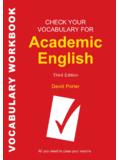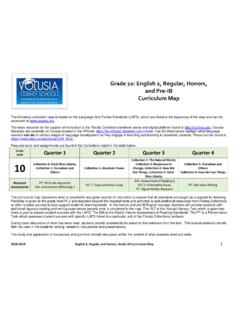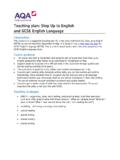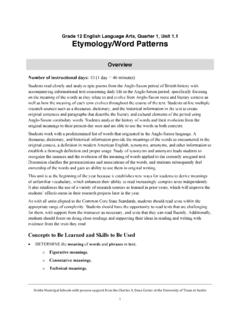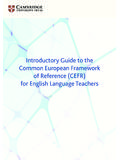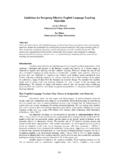Transcription of GLOSSARY OF ENGLISH LANGUAGE ARTS TERMS
1 121 GLOSSARY OF ENGLISH LANGUAGE ARTS TERMS Adapted text (simplified). Substitutes linguistically frequently occurring vocabulary for infrequently occurring nontechnical vocabulary , shortens sentence length, lowers reading level, and restructures sentences to reduce their complexity. See Adapted text (elaborated). Clarifies, elaborates, and explains implicit information and makes connections explicit with words sometimes added to increase comprehension. See Assistive technology. Any item, piece of equipment, or product system, whether acquired commercially, modified, or customized, that is used to increase, maintain, or improve the functional capabilities of individuals with disabilities. See Context clues.
2 Bits of information from the text that, when combined with the reader's own knowledge, help the reader determine the meaning of the text, or unknown words in the text. Decoding. Understanding that a printed word represents the spoken word, and that this printed word is made of a sequence of phonemes. Digital literacy. Ability to use digital technology, communication tools, or networks to locate, evaluate, use and create information; ability to understand and use information in multiple formats from a wide range of sources when it is presented via computers; person s ability to perform tasks effectively in a digital environment. Literacy includes the ability to read and interpret media, to reproduce data and images through digital manipulation, and to evaluate and apply new knowledge gained from digital environments.
3 See Digital tools. Tools that involve or relate to the use of a computer/technology. Distracters. An incorrect choice among multiple-choice answers on a question or test. See Encode. To represent complicated information in a simple or short way. Episode. A brief unit of action in a literary work; a situation that is part of a narrative. Figurative LANGUAGE . Uses "figures of speech" as a way of saying something other than the literal meaning of the words ( , All the world's a stage.); hyperbole, metaphor, onomatopoeia. Figurative meaning. Exaggerated or altered meaning of words used as a figure of speech ( , She swims like a dolphin (simile); figurative meaning is that she swims very well.). Formal LANGUAGE .
4 Adheres to stricter grammar rules, does not follow informal, spontaneous LANGUAGE ( LANGUAGE between friends). Graphic organizer. A diagram or pictorial device used to record and show relationships among ideas or information. An example could be a Venn diagram or a T-chart. Guided writing activities/lessons. Temporary, small group lessons teaching strategies that students most need to practice with guidance from a teacher. See High-frequency words. Words that appear frequently in writing, reading, and LANGUAGE . Hyperbole. Way of speaking or writing (emphatic exaggeration) that makes someone or something sound bigger, better, more, etc. than they are ( , You ve grown like a bean sprout!). Idiom. Words in a fixed order that have a particular meaning that is different from the meaning of each word separately ( , "Bitten off more than you can chew.)
5 "; It s raining cats and dogs. ; and A little under the weather. 122 Independent writing. Children write their own pieces, such as stories and informational narratives, retellings, labeling, speech balloons, lists, etc. See Inference. Assuming that something is true or forming an opinion based on information. Informational (natural) LANGUAGE . Refers to spontaneous LANGUAGE ( LANGUAGE between friends) that has less strict grammar rules and/or shorter sentences. Informational text. Text that intends to provide information on a particular topic ( , an essay written about the Battle of Gettysburg). Informational essay/text/writing. Writing that intends to provide information on a particular topic ( , Students write informational pieces about the effects of global warming, the impact of women in politics, and the salaries and endorsements in professional sports.)
6 Intonation. The sound changes produced by the rise and fall of the voice when speaking, especially when this has an effect on the meaning of what is said. Literary elements. Characterizations, setting(s), plot(s) (including exposition, rising action, climax, and falling action), and theme(s) developed by an author over the course of a story. Metaphor. An expression (figure of speech) which describes a person or object in a literary way by referring to something that is considered to have similar characteristics to the person or object being described, such as The mind is an ocean, and The city is a jungle. Multimedia book. Combines media of communication ( , text, graphics, and sound). Multimodal. Having or involving several or a combination of learning styles, modes, or modalities ( , auditory, kinesthetic, visual, or a combination).
7 Onomatopoeia. The creation and use of words which include sounds that are similar to the noises (imitates) that the words refer to ( , hiss, buzz, bang, or the word zip imitates the sound of zipping up one s coat). Open-ended questions. A question beginning with such words as what, why, how, describe that are designed to encourage a full, meaningful answer using the subject's own knowledge and/or feelings. See and Phonemes. Abstract units of the phonetic system of a LANGUAGE that corresponds to a set of similar speech sounds (as the velar \k\ of cool and the palatal \k\ of keel) which are perceived to be a single distinctive sound in the LANGUAGE . See Phonetic spelling. The representation of vocal sounds which express pronunciations of words and a system of spelling in which each letter represents invariably the same spoken sound.
8 See Picture exchange cards (PECS). Originally created by Pyramid Products as a tool for communicating with non-verbal people on the spectrum. Since its invention, though, "PECS" has become shorthand for any kind of image-based communication. Prompt levels/prompt hierarchy. To make something happen. Verbal prompts - Statements that help learners acquire target skills ( , You might need to try it a different way, Write your name. ). Gestural prompts - Movements that cue learners to use a particular behavior or skill ( , pointing to the top of the paper where the learner needs to write his name). Model prompts - Models the target skill or behavior. Full model prompts can be verbal if the skill being taught is verbal, or they can be motor responses if the skill being taught involves moving a body part.
9 Physical prompts - Touches to help a student use the target behavior or skill ( , tapping a learner s hand to cue writing, putting hand over learner s to help writing). 123 Visual prompts - Pictures of events that provide learners with information about how to use the target skill or behavior ( , task analysis checklist, transition picture card). See Roots (morphemes). The most basic form of a word that is still able to convey a particular thought or meaning. Segmental phonemes. One of the phonemes (as \ k, a, t \ in cat, tack, act) of a LANGUAGE that can be assigned to a relative sequential order of minimal segments. See Sensory LANGUAGE /sensory words. Words that refer to the senses of sight, touch, hearing, smell, and taste that can help add realism to writing.
10 Shared reading. An interactive reading experience where children interact with the reading of a big book or other enlarged text as guided by a teacher or other experienced reader, generally accomplished using an enlarged text that all children can see. See Shared writing activity/modeled writing. An approach to writing where the teacher and children work together to compose messages and stories where children provide the ideas and the teacher supports the process as a scribe. The message is usually related to some individual or group experience. The teacher provides full support, modeling and demonstrating the process of putting children's ideas into written LANGUAGE . See Short essay. Literary composition on a single subject, usually presenting the personal view of the author.










